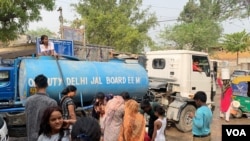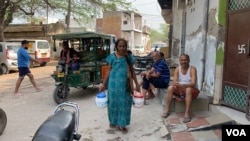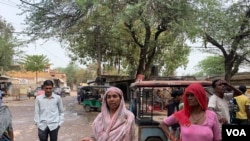New Delhi —
Mushrat Parveen, a resident of a low-income neighborhood in the Indian capital, New Delhi, perches atop a tanker truck delivering water to her neighborhood to escape the chaos that ensues.
“Everyone keeps fighting for water, so I climb on top and use a pipe to make sure I fill two or three buckets. Then I help others,” says Parveen, who in recent weeks has been spending about two hours daily first waiting for the truck, then filling containers and lugging them home.
As taps in urban slums and working-class areas in Delhi run virtually dry, millions have been depending on water ferried by government tankers. It is not the only Indian megacity running low on water. Two months ago, a similar crisis afflicted India’s information technology hub, Bengaluru.
Water shortages are not new in urban India — the scramble for water in low-income areas has been a familiar scene during summer months for many years. But they have been worsening. Amid a weekslong, searing heat wave that gripped Delhi, the city became so parched this season that police were deployed to guard water pipes.
New Delhi’s water minister, Atishi, recently staged a hunger strike for four days, alleging that the neighboring Haryana state was not providing the city its share of water from the Yamuna river that runs through both places, resulting in acute scarcity.
“There are 2.8 million people in the city who are aching for just a drop of water,” she said. Her worsening health forced her to call off the protest on Tuesday.
Political disputes over sharing of water from common rivers have often erupted when shortages intensify.
Experts say rapid urbanization is exacerbating a problem that has been building in recent years.
“What’s happened is that most Indian cities have grown so fast that the water supply networks have not kept up with the rate of growth. Its unprecedented crazy growth,” said Veena Srinivasan, executive director with non-profit WELL Labs.
The populations of Delhi and Bengaluru have more than tripled in about three decades. Delhi is now home to nearly 20 million people while Bengaluru’s population is estimated at 14 million.
These cities have become home to upscale commercial hubs and industries as India’s economy booms, requiring more quality, fresh water. As a result, lakes and rivers harnessed to provide water have been shrinking and ground water levels plummeting.
A 2018 government report said that nearly 600 million people in the country are facing high to extreme “water stress.” That adds more than 40% of the country’s population.
While upscale neighborhoods in Delhi face virtually no scarcity of clean water, experts say slums are the most parched areas in the city.
“In some places especially the lower socioeconomic areas, we find that water availability is as low as 35 to 40 liters per capita per day. So, the distribution of water is iniquitous. On top, climate change comes as a force multiplier,” said Anjal Prakash, research director at the Bharti Institute of Public Policy.
He says lack of investment in infrastructure such as water pipes and storage tanks has made the problem worse. “We have done some patchwork, but we have not done an integrated analysis of how this should be running. Delhi, for example, the leakage from the water infrastructure is about 58%.”
While India is a water-stressed country, the severe shortages cannot just be blamed on a shortfall of water, according to experts. Pointing to poor water management, they say authorities have not paid enough attention to strategies such as recycling wastewater or rainwater harvesting that would help conserve monsoon rains.
Experts say low water tariffs charged in India have also discouraged sufficient investment in schemes that could augment supplies.
“If water is free most of the time, the incentive to invest in good technology to really treat water, the incentive to harvest every last drop of rainwater, simply is not there, because it is not seen as a precious resource that is scarce. That remains a problem we have to grapple with in urban India,” points out Srinivasan.
For many Delhi residents, lives are upended by the water crisis every summer. Elderly residents like 82-year-old Kamlesh Devi say they cannot cope with the elbowing and shoving that ensues when tankers arrive.
“Four to six people come from one household and corner many buckets. Some of us keep standing. If we object, a scuffle ensues,” she says as she carries back two small containers that she will keep aside for drinking.
Ayesha Khatun, a diabetes patient relies on her family members to fetch water for cooking and cleaning because she cannot carry the buckets. “Our work gets affected. My husband sometimes loses a day’s work. My daughter has to skip school,” says Khatun. “And it is common for people to get hurt during the scuffles while filling water.”
With heat waves and water shortages likely to worsen, the situation in urban India could become grimmer, experts warn.
Source: voanews.com






